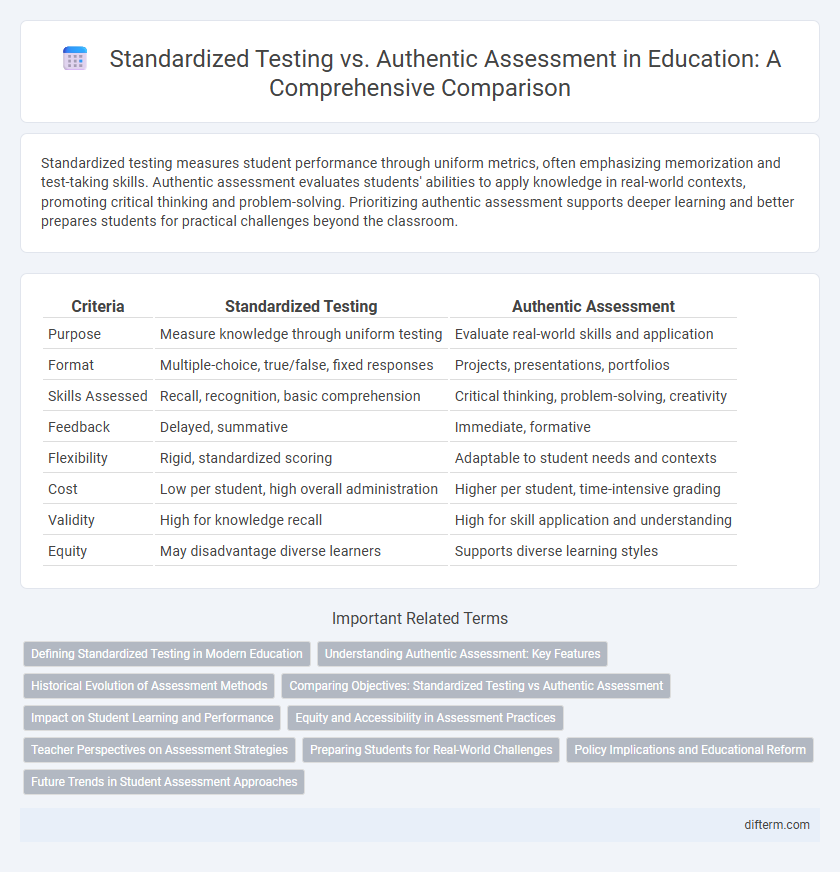Standardized testing measures student performance through uniform metrics, often emphasizing memorization and test-taking skills. Authentic assessment evaluates students' abilities to apply knowledge in real-world contexts, promoting critical thinking and problem-solving. Prioritizing authentic assessment supports deeper learning and better prepares students for practical challenges beyond the classroom.
Table of Comparison
| Criteria | Standardized Testing | Authentic Assessment |
|---|---|---|
| Purpose | Measure knowledge through uniform testing | Evaluate real-world skills and application |
| Format | Multiple-choice, true/false, fixed responses | Projects, presentations, portfolios |
| Skills Assessed | Recall, recognition, basic comprehension | Critical thinking, problem-solving, creativity |
| Feedback | Delayed, summative | Immediate, formative |
| Flexibility | Rigid, standardized scoring | Adaptable to student needs and contexts |
| Cost | Low per student, high overall administration | Higher per student, time-intensive grading |
| Validity | High for knowledge recall | High for skill application and understanding |
| Equity | May disadvantage diverse learners | Supports diverse learning styles |
Defining Standardized Testing in Modern Education
Standardized testing in modern education refers to a uniform assessment method designed to evaluate student performance consistently across diverse populations using predetermined metrics and multiple-choice or short-answer questions. These tests aim to provide measurable data on academic achievement, enabling comparisons at local, state, or national levels. However, critics argue that standardized testing often fails to capture critical thinking, creativity, and real-world problem-solving skills emphasized in authentic assessment models.
Understanding Authentic Assessment: Key Features
Authentic assessment emphasizes real-world tasks that demonstrate students' critical thinking, problem-solving, and application skills beyond traditional standardized testing. Key features include performance-based evaluation, integration of complex, meaningful activities, and opportunities for self-reflection and peer collaboration. This approach provides a comprehensive understanding of student learning by assessing abilities in context rather than relying solely on multiple-choice or time-constrained formats.
Historical Evolution of Assessment Methods
Standardized testing originated in the early 20th century, emphasizing uniformity and objective measurement to compare large student populations, as seen in the development of the SAT and IQ tests. Authentic assessment emerged in the late 20th century, focusing on real-world tasks and performance-based evaluations to better capture student understanding and skills relevant to practical contexts. The shift reflects educational priorities evolving from ranking and classification toward fostering critical thinking, creativity, and application of knowledge.
Comparing Objectives: Standardized Testing vs Authentic Assessment
Standardized testing primarily measures students' mastery of specific content and skills through uniform, objective metrics, ensuring comparability across diverse populations. Authentic assessment evaluates students' abilities in real-world contexts, emphasizing critical thinking, problem-solving, and application of knowledge. The differing objectives highlight standardized tests' focus on quantifiable achievement, while authentic assessments prioritize deeper understanding and transferable competencies.
Impact on Student Learning and Performance
Standardized testing provides quantifiable data for comparing student performance across diverse populations, but it often fails to capture critical thinking and creativity essential for deep learning. Authentic assessment engages students in real-world tasks, promoting higher-order skills and a more accurate reflection of their abilities and knowledge application. Emphasizing authentic assessment can lead to improved student motivation, deeper understanding, and enhanced performance outcomes in complex problem-solving contexts.
Equity and Accessibility in Assessment Practices
Standardized testing often presents barriers for diverse learners due to rigid formats and cultural biases, limiting equitable access to fair evaluation. Authentic assessments, designed around real-world tasks and adaptable formats, enhance accessibility by accommodating different learning styles and backgrounds. Emphasizing equity in assessment practices requires integrating diverse evaluation methods that recognize varied competencies beyond traditional testing constraints.
Teacher Perspectives on Assessment Strategies
Teachers often highlight that standardized testing provides uniform metrics for student evaluation but may overlook individual learning styles and critical thinking skills. Authentic assessments, such as project-based tasks and portfolios, enable educators to gauge real-world application and deeper comprehension, aligning more closely with diverse student needs. Many educators advocate for a balanced approach, combining quantitative data from standardized tests with qualitative insights from authentic assessment to enhance instructional strategies and student outcomes.
Preparing Students for Real-World Challenges
Authentic assessment emphasizes critical thinking, problem-solving, and practical application of knowledge, better preparing students for real-world challenges than standardized testing, which often prioritizes rote memorization and limited skill sets. By engaging students in projects, portfolios, and real-life scenarios, authentic assessments develop adaptability and creativity essential for modern careers. This approach aligns more closely with workforce demands, fostering lifelong learning and meaningful skill transfer beyond academic settings.
Policy Implications and Educational Reform
Policy implications of standardized testing emphasize uniform benchmarks and accountability measures that often influence curriculum design and resource allocation. Educational reform advocates for authentic assessment to promote critical thinking, creativity, and real-world skills by integrating performance-based tasks and project-based learning. Balancing standardized metrics with authentic evaluations can foster equitable educational outcomes and support diverse learner needs in policy frameworks.
Future Trends in Student Assessment Approaches
Future trends in student assessment emphasize a shift from traditional standardized testing toward authentic assessment methods that measure real-world skills and critical thinking. Emerging technologies like AI-driven analytics enable personalized feedback and adaptive testing, enhancing the accuracy and relevance of evaluations. Education systems increasingly prioritize assessments that foster creativity, collaboration, and problem-solving to better prepare students for rapidly evolving workforce demands.
standardized testing vs authentic assessment Infographic

 difterm.com
difterm.com